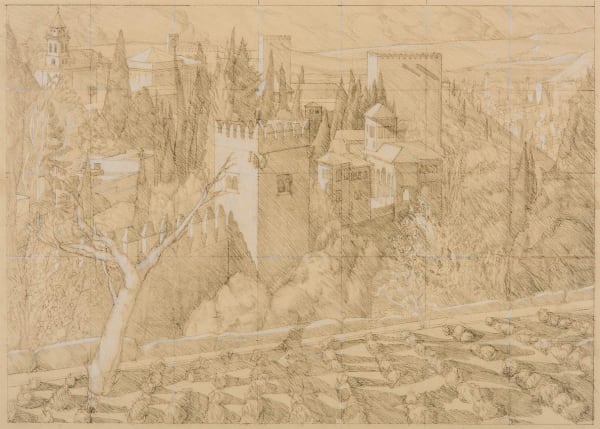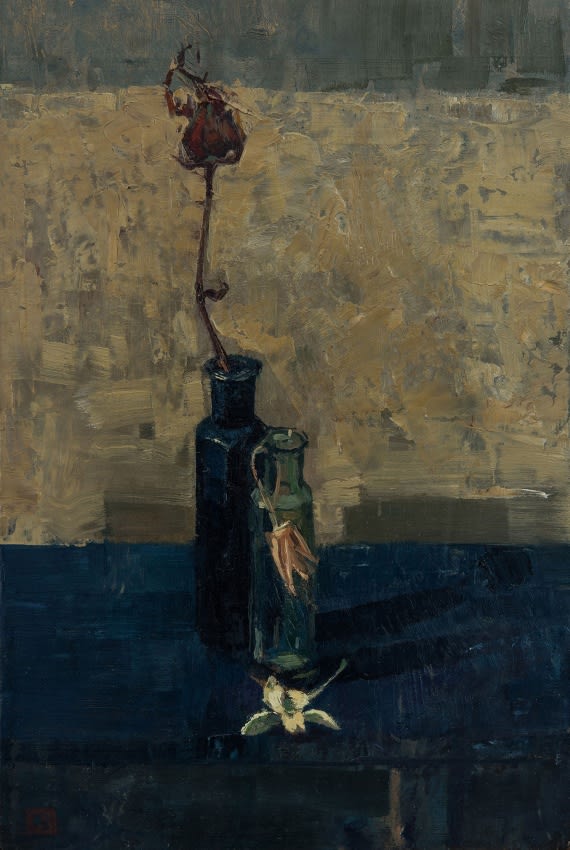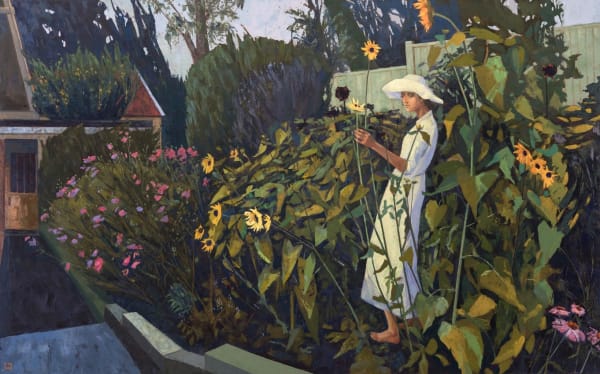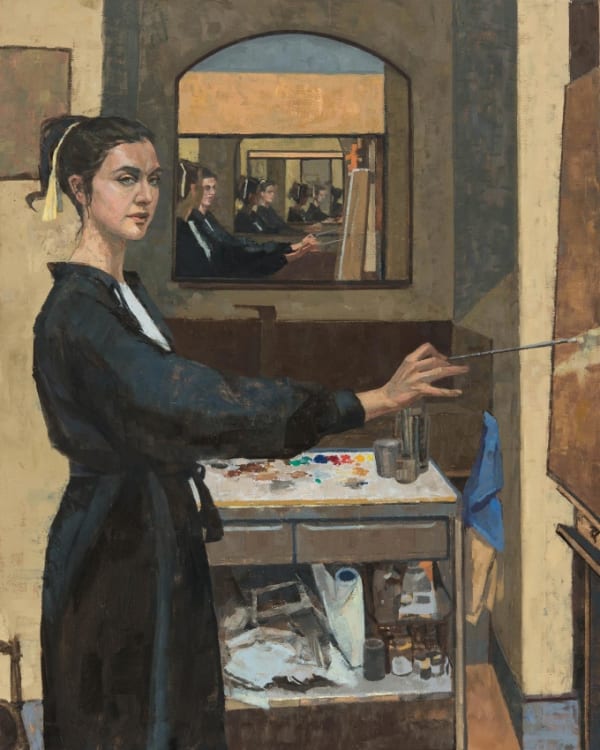Fresh from her recent exhibition in Oxfordshire (a joint show with her artist husband, Saied Dai) Charlotte Sorapure took some time to tell us about her work, technique, inspirations and what it's like to have an Olympic wrestler as a life drawing teacher. . .
"The importance of drawing was instilled in me at a very early stage. Even before my foundation course at Bournemouth and Poole College of Art and Design, I would attend life drawing classes with an artist and teacher called Sam Rabin. Intimidating and larger than life, he had also been a wrestler, winning a bronze medal in the 1928 Olympics. In stark contrast to this, his drawings and paintings were beautifully delicate and subtle.
After doing a BA in Cheltenham, I was lucky enough to get a place at the Royal Academy of Arts, at a time when the importance of drawing was still recognised as a fundamental means of exploring the nature of all visual relationships. Even in the life-room, drawing was not seen merely as a ‘skill’, which is misguidedly thought today, but more a question of learning how to see, and translate what one sees.
The strongest advocates of this were Norman Blamey RA and Roderick Barrett. The former, was masterful in his ability to conceive of the human form, in all its complexity and yet explain it with lucid simplicity. Although modest in scale, his demonstration drawings, were monumental in their understanding. Roderic Barrett was equally remarkable. His insights into the ‘visual dynamics’ of an image, meant that his observations and advice on composition were invaluable – and went far beyond aesthetics.
It was whilst studying on my degree course that I sold my first painting, to one of my art history tutors, Alan Ford. A little seascape with an orange boat in it. He proudly displayed it in his office, only to have it stolen a few weeks later . . . it was never found!
Artist I admire? All the good ones!
Influences can come from the most unexpected sources, which have resonated and manifested in oblique and unlikely ways. These ideas penetrate, filter and become assimilated through your own temperament and understanding.
Whenever asked which artists I admire, the response is usually just “all the good ones!” There are too many to mention, but a few would be Stanley Spencer, Richard Eurich, Gwen John, Samuel Palmer, Zurbaran, Artemisia Gentileschi and Renaissance painters such as Masolino, Ghirlandaio and Benozzo Gozzoli. Stanley Spencer manages to make an event that is both pictorial and poignant, out of something mundane, such as a pile of satchels or figures swathed in mosquito nets. I admire the way he is able to combine the modest and humble with the symbolic, and in doing so, achieve a believable and touching humanity.
A recent commission
A recent commission gave me a chance to create a more expansive composition, based on studies and drawings made in Granada, Spain a few years ago. Commissions vary from studio work, in the sense that there is 'a brief'. For all concerned, it is best if the artist can pursue an avenue that they find stimulating. Despite the obvious limitations, these constraints can actually help produce work that might not have been considered before, so can be extremely interesting and rewarding.
The aim was to create a colourful, uplifting landscape that the viewer could enter and travel through, including aspects of the Islamic Architecture and formal gardens of the Alhambra. After making several compositional studies [see 'Alhambra drawing study', below] looking at the placement and relationship of intervals, shapes and rhythms, the final drawing was squared up and transferred to a four- by six-foot canvas.

I worked on it for many months, subtly altering and shifting elements in order to emphasise and best express the atmosphere. Although the scene is straightforward, there is a dead olive tree in the foreground – its ossified limbs thrusting out, give it an almost balletic theatricality. [see 'Memories of a Forgotten City', below]

Like playing in different musical keys
Oil paint is the most versatile and extensive of all the mediums. It can produce a surface that ranges from the finest glass finish to the roughest and broadest impasto. It is also very forgiving, in the sense that alterations can be made indefinitely, and more importantly it gives one time to consider what is being done. I will vary my palette relative to the requirements of the subject, often reducing it to a limited scheme if need be. It is like playing in different musical keys, as the subject demands. Limiting the palette allows you to work within a tight constraint, which in itself produces a stronger flavour for the final image.

Persephone
Summer, or the fruits of it, are a feature of many of my recent paintings. This abundant yet fleeting season, has often been a poignant metaphor for the cycle of life.
The subject of this painting is Persephone who was seized by Hades and carried off to the underworld. She was doomed to spend half of the year with Hades and only allowed to return to earth in spring. This accounted for the seasons in ancient Greek myth.
In my painting, the arrival of Hades to spirit Persephone away, is suggested by a gust of wind and the dark slightly anthropomorphic tree form which looms above. Her impending fate is implied by flecks of pure colour in the undergrowth, that are not just hidden flowers, but could read as eyes, glinting, watching and peering out. There is even a small animal skull amongst the leaves; as the name Persephone is derived from ‘pherein phonon’, meaning to ‘bring or cause death’.
Although some of the paintings like this one are obviously based on myths or archetypes, most just have a suggestion of a narrative. I am often hinting at a kind of poetic awareness rather than any literal story – to hopefully give the viewer a sense of the underlying mood or character of a place or an object. To do so, one must be constantly alert to the possibilities of potential subjects.
The viewer and the critic
I am conscious of the viewer in the sense of trying my best to communicate, but pandering to expectation is fatal. It is always better to leave the audience pondering the subtleties and ambiguities of the subject. The image should leave a residue that lasts well beyond the few moments spent in front of the painting. I am always trying to improve, so welcome objective criticism, but find it is best not to take compliments or criticism to heart . . . both can be wrong!
Having said that, it is helpful to have another painter as a partner, in order to get some objective, honest feedback. Sometimes, you are the last person to spot a problem. I am married to the artist Saied Dai and we often give each other criticism and advice about paintings.
We spent two years building a studio in the garden, as my old studio in the house was very cramped and we had run out of space. The disruption and trauma of all the building work was considerable, but I am now finally able to enjoy the benefits of it.

Several works on the go
I tend to work quite late into the evening, but the average day would entail firstly getting some of the inevitable ‘admin’ out of the way. I try to make sure I am in the studio by mid-morning, and what usually confronts me then is a row of unfinished paintings! I find it helpful and stimulating to have several works on the go simultaneously. It is necessary to have a break from one image, as it can easily become stale. They can also feed off one another, switching from an observed to an invented image; the objectivity of one and the lyricism of the other, remind me that good paintings need to have both those qualities.
Painting is always difficult, and the reality often falls short of ones hopes and aspirations. As an image progresses and needs to be fixed, the possibilities and avenues narrow, and the quality of decision-making becomes increasingly demanding, but fascinating.
On the New English Art Club
I became a member of the New English ten years ago. There is a wonderful sense of community and camaraderie, which is very important, especially as this is such a solitary occupation.
The most recent project was a show at Brian Sinfield Gallery [view works] in Oxfordshire last month. After working solely on this for some time, I can now focus on other ideas for paintings that have been ‘waiting in the wings' . . ."
Find out more about Charlotte Sorapure on her artist profile page where you will also find original artworks for sale.








